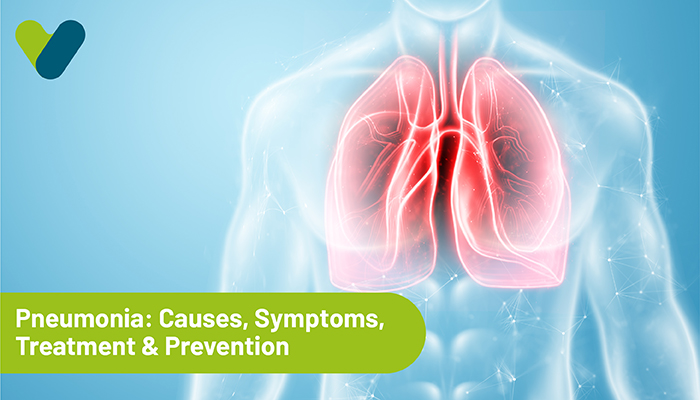PLaPneumonia is a pulmonary infection that primarily affects the air sacs or alveoli in the lungs. The infection can be caused by bacteria, virus or fungi. The alveoli may fill up with fluid or purulent material like pus, which, in turn, causes cough, fever and breathing difficulties. Pneumonia symptoms can vary depending on your age and general health conditions. While mild symptoms of pneumonia resemble common respiratory infections, the illness can aggravate into a severe state if they are not addressed as soon as they appear. Additionally, pneumonia caused by bacteria or viruses is contagious. An infected person can infect others through coughs, sneezes, shared utensils, unhygienic practices, etc. On the other hand, fungal or aspiration pneumonia is not contagious.
Pathophysiology Of Pneumonia
Pneumonia is an umbrella term for a group of syndromes caused by pathogens or other agents that cause lung infection. As human beings, we regularly inhale pathogens and microbes. These micro-organisms live in the upper parts of the respiratory system and cause no trouble. Usually, the body's defence mechanisms prevent such organisms from spreading in the body. The immune system, epithelial barrier, mucous entrapment, etc., are ways the body fights infection. In some cases, the pathogens and microbe overpower the defence mechanisms. This allows them to reproduce and colonise the lungs, resulting in pneumonia. The lung tissues swell and can cause two types of pneumonia:- Bronchopneumonia This type of pneumonia infects the bronchi in both the lungs. Bronchi are tubes that extend from the trachea (windpipe) to the lungs.
- Lobar Pneumonia Each lung is divided into lobes. The right lung has three lobes – superior, middle, and inferior lobe. The left lung has two lobes – superior and inferior lobe. Lobar pneumonia can affect one or more lobes of either of the lungs. Lobar pneumonia is further divided into the below four phases.
- Phase 1: Congestion Congestion occurs within 24 hours of infection. The number of pathogen-fighting white blood cells present in the lungs are less than the pathogens. The lungs become heavy and red while the alveolar wall capillaries become congested with fluids. Symptoms include coughing and deep breathing.
- Phase 2: Red Hepatisation In this stage of pneumonia, the lungs become firm and airless and almost resemble the liver. Alveolar capillaries are filled with blood while congestion persists. Red and white blood cells and other cellular debris clog the lung airways. Red hepatisation occurs after 48 hours and can last for up to four days.
- Phase 3: Grey Hepatisation This stage occurs after four to six days of the infection and lasts for up to eight days. The lungs become grey or yellow while still resembling the liver. Fibrin, haemosiderin and red blood cells break into fluid-like exudates. Macrophages start to develop as well.
- Phase 4: Resolution The final stage of pneumonia is the recovery stage. It occurs after eight to ten days of the infection. The body absorbs all the fluids and debris that were broken down during the above stages. The macrophages help to clear out the remaining debris, which is expelled from the body through coughing. In this stage of pneumonia, the airways and air sacs resume normal lung function.
Pneumonia Disease Causes
Infection in the lungs is the primary cause of Pneumonia. Bacteria or viruses are the primary cause of the infection, but in some cases, fungi or other microorganisms may be responsible. Lung infection symptoms include swelling and leaking fluids.Some of the most common illnesses that can cause Pneumonia include:
- COVID-19
- Common Cold
- Human metapneumovirus (HMPV)
- Human parainfluenza virus (HPIV)
- Respiratory syncytial virus (RSV), etc.
Causes of Pneumonia in Adults
The causes of Pneumonia in adults are most commonly infections. Factors such as age, underlying health conditions, and lifestyle choices can increase the chances of other illnesses causing pneumonia.Excessive smoking, substance use, and poor nutrition are some of the most common reasons for a weak immune system in adults. These habits can worsen lung infection symptoms. Adults with underlying health conditions like asthma, cystic fibrosis, diabetes, liver or kidney disease, etc., are at a high risk for pneumonia-like complications.
External factors also play a crucial role in increasing the likelihood of pneumonia. Exposure to certain chemicals, pollutants, or toxic fumes can irritate and weaken your lungs. Patients of long-term hospitalization often have severely weakened immune systems, increasing their chances of an infection.
Types Of Pneumonia
Pneumonia is categorised by the type of pathogen that causes it and the way you contract it. The following are the different types of pneumonia:- Community-Acquired Pneumonia (CAP)
Pneumonia that you contract in a community setting outside hospitals is called community-acquired pneumonia. It is further divided into:
- Bacterial Pneumonia Bacterial pneumonia is caused by the bacteria Streptococcus pneumoniae. Also known as pneumococcal disease, it is the most common type of CAP. Other common bacteria include Mycoplasma pneumoniae, haemophilus influenzae and Chlamydophila pneumoniae. When an infected person coughs or sneezes, they release bacteria-filled droplets into the air. If you happen to breathe such particles through the nose or mouth, you can contract bacterial pneumonia.
- Viral Pneumonia As the name suggests, viral pneumonia is caused by a virus. Common pneumonia-causing viruses include influenza virus, adenovirus, rhinovirus, chickenpox, coronavirus, respiratory syncytial virus (RSV), etc. Some common symptoms include viral fever, cough, muscle pain, headache, runny nose, etc. If you catch viral pneumonia, you are at a greater risk of developing pneumococcal disease. Different viruses become pervasive during different seasons.
- Fungal Pneumonia Fungal pneumonia is caused by fungi and is common amongst people with compromised immune systems or chronic health conditions. The likelihood of death due to such type of pneumonia is greater if the person is immunocompromised. You can contract fungal pneumonia even if you're healthy. Common fungi that cause fungal pneumonia are Coccidioides immitis, Pneumocystis jirovecii, Cryptococcus species, etc.
- Hospital-Acquired Pneumonia (HAP) Your lungs can get infected with HAP 48 hours after being admitted in a hospital. The pathogens present in a hospital environment are often more dangerous. They are typically more resistant to treatment than the ones responsible for CAP. Plus, if you're already sick, your body may not have adequate resistance against strong hospital pathogens. Patients on ventilators or with chronic diseases are more likely to develop HAP. Patients who've had open chest surgeries, cancer treatments, or severe wounds can also catch HAP.
- Aspiration Pneumonia Pneumonia that occurs when you accidentally breathe food or liquid into the lung airways is called aspiration pneumonia. Besides foods and liquids, you may also breathe saliva or vomit into the lungs. Being in a coma, drinking excess alcohol, poor gag reflexes and old age are some factors that can make you breathe food and other items instead of swallowing them. Patients who have trouble swallowing may have to rely on other feeding methods to reduce the risk of aspiration pneumonia.
Who Is At Risk Of Pneumonia?
Pneumonia disease can infect anyone, at any time. However, the following people are at a greater risk of developing pneumonia fever than others.- Children aged two years and below
- Adults aged 65 years and above
- Hospital patients
- People who smoke
- Pregnant women
- People with pre-existing or congenital pulmonary or cardiovascular conditions, including, asthma, cystic fibrosis, chronic obstructive pulmonary disease (COPD), pulmonary fibroses, sarcoidosis, etc.
- People with neurodegenerative conditions like dementia or Parkinson's. Such individuals are at risk of developing aspiration pneumonia as they typically experience difficulties while swallowing.
- People with a compromised immune system. You may have a weakened immune system if you're undergoing chemotherapy, or you are an organ transplant recipient. People with Human Immunodeficiency Virus (HIV) infection and Acquired Immune Deficiency Syndrome (AIDS) are at a greater risk of contracting pneumonia disease.
Early signs of pneumonia
Early signs of pneumonia can often be mistaken for a common cold or flu. The symptoms include dry cough, mild fever, chills, and fatigue. While the common cold can lead to pneumonia, it usually clears up with rest, hydration, and medication. Pneumonia, however, begins with persistent symptoms. It is best to consult a doctor right away if these early signs worsen or persist longer than a common cold symptom.You can also look out for chest pain, shortness of breath, muscle aches, and confusion (particularly in older adults). These can also be early signs of pneumonia.
Symptoms Of Pneumonia
Depending on the type of pneumonia, the symptoms can vary. You are likely to develop a cluster of the following symptoms:- High fever
- Cough with phlegm (thick and discoloured mucus)
- Extreme fatigue
- Shortness of breath
- Rapid breathing (tachypnoea)
- Rapid heart rate
- Chest, abdomen and muscle pain
- Appetite loss
- Bluish lips and fingernails
- Pale skin
- Sweating
- Chills
- Headache
- Sudden mood changes
Contagious pneumonia symptoms
Bacterial and Viral Pneumonia are highly contagious. Since it is a respiratory disease, it can spread quickly through the air. The most common way is through coughs and sneezes.Typically, pneumonia presents as a persistent cough or sneeze, shortness of breath, and chest pain. If an infected person coughs or sneezes without covering their mouth, droplets can land on surfaces, another person, and linger in the air. These droplets are then ingested or inhaled by another person, and the disease continues spreading.
Pneumonia Symptoms In Children
Children, especially infants, are easy targets as their immune system is relatively weak and their lungs are still developing. Children with pneumonia may exhibit the following symptoms:- Fever
- Difficulty breathing
- Vomiting
- Restlessness
- Appetite loss
- Flushed skin
- Pale skin
- Inability to ingest food
- Decreased urine
- Excessive crying
- Grunt breathing sounds
How does pneumonia spread?
Pneumonia spreads from person to person through respiratory droplets. When an infected person coughs or sneezes, droplets are released into the air. These droplets are then inhaled by others, thereby causing infection. Respiratory droplets can land on surfaces, too. In some cases, pneumonia can spread through the blood, such as during or right after childbirth.Different types of pneumonia spread through the body in different ways. For instance, Aspiration Pneumonia spreads through accidentally inhaling food, drink, or saliva particles into the lungs. This happens when the gag reflex is weak or the person has issues with swallowing.
Pneumonia Fever Diagnosis
If you notice pneumonia symptoms, you should get tested for it at the earliest. Otherwise, the condition can become invasive and severe. Your doctor may confirm the incidence of pneumonia with the following diagnoses:- Physical Exam Your doctor may ask you about your medical history and attempt to assess your lung health using a stethoscope. This type of physical exam helps them check for abnormal sounds that may be caused due to pneumonia.
- Chest X-Rays A chest X-ray helps the doctor view the location and extent of lung infection. However, an X-ray does not tell you the type of pathogen causing the pneumonia fever.
- Blood Tests Blood culture tests help identify the germs causing the infection. The doctor may also prescribe other tests as blood tests may sometimes not suffice.
- CT Scan Computed tomography (CT) scan captures internal images of the body. If the pneumonia disease is persistent, your doctor may ask for a CT scan to ascertain the cause.
- Sputum Test In a sputum test, the doctor asks you to cough deeply and spit the mucus into a cup. The doctor then sends the sample for testing to assess signs of infection.
- Pulse Oximetry This test measures the oxygen saturation in the blood, allowing doctors to assess your lung function.
- Pleural Fluid Culture The doctor inserts a thin needle in the pleural cavity to extract the pleural fluid and tests it to determine the type of pneumonia infection.
- Bronchoscopy A pulmonologist or lung doctor inserts bronchoscope (a thin tube) into the lungs through the nose or mouth, which allows them to look inside the lungs and confirm pneumonia diagnosis.


